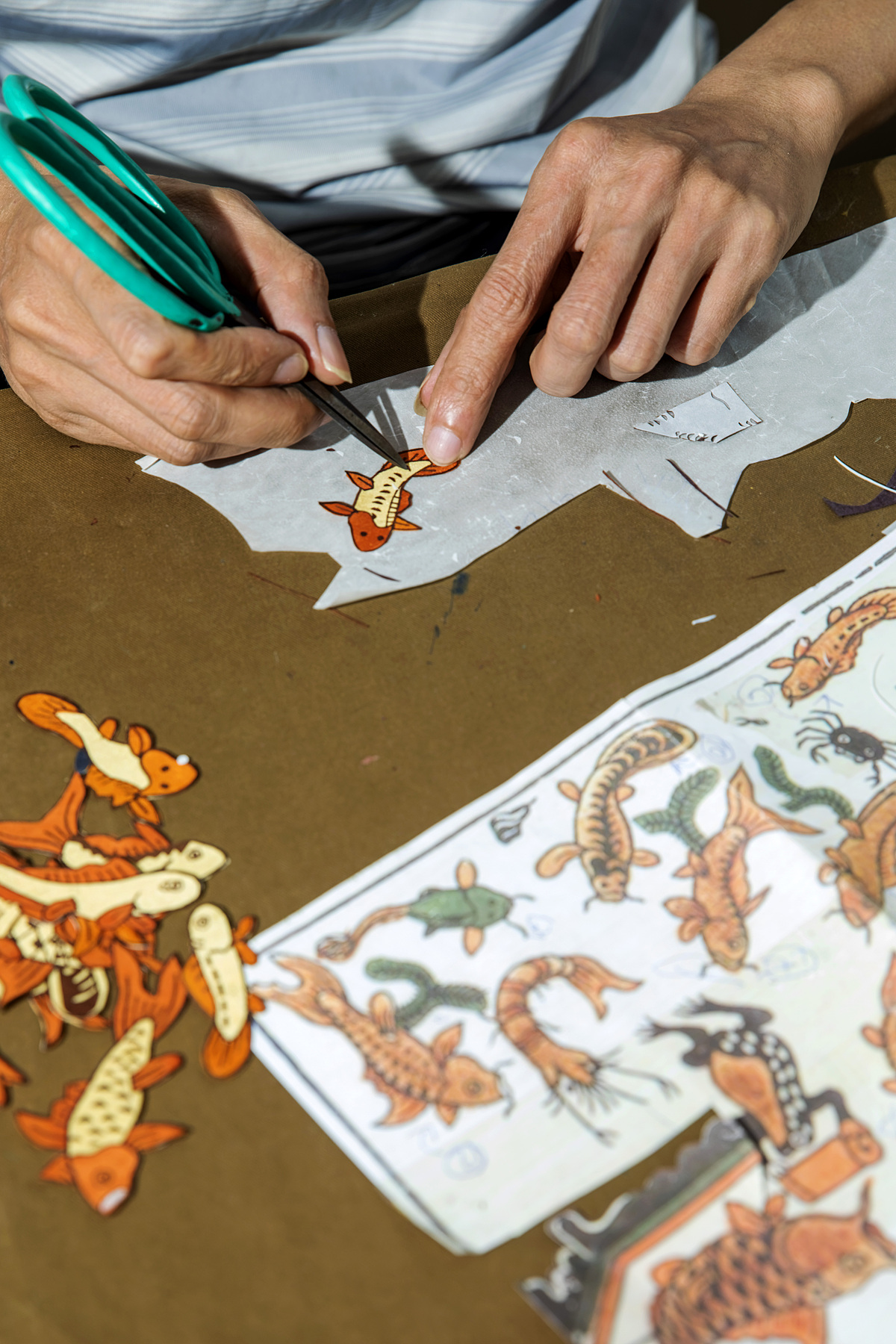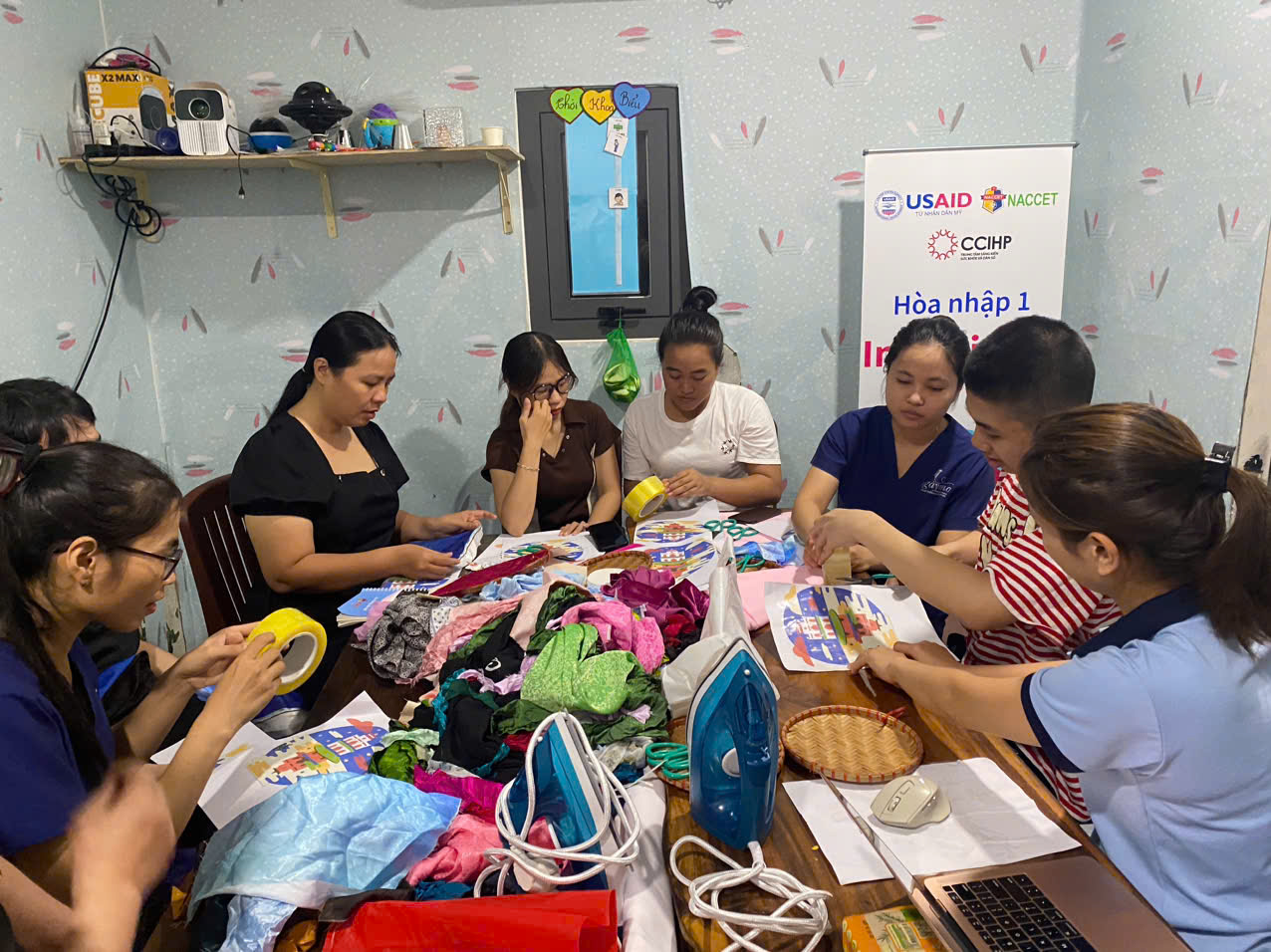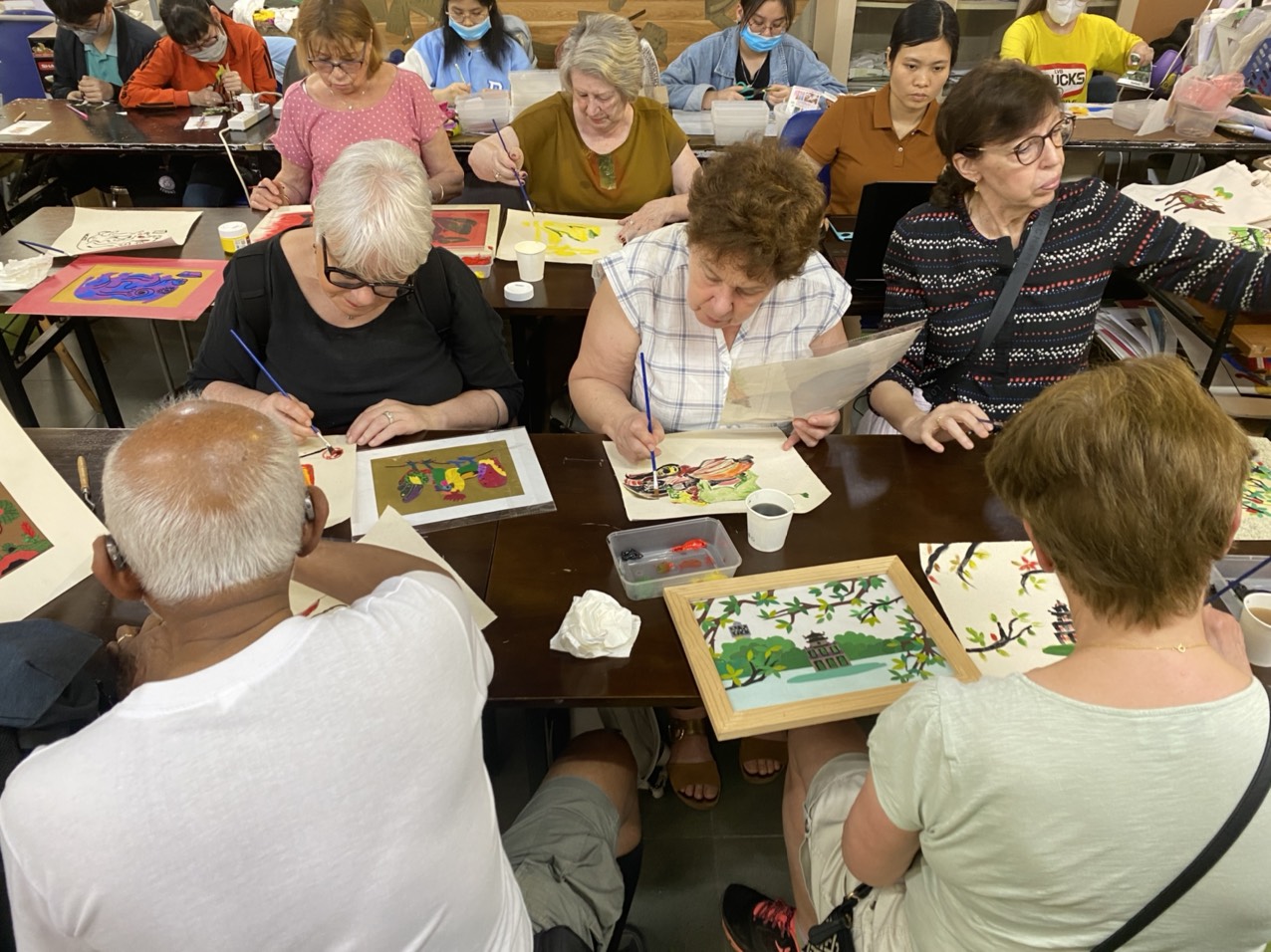In a 125-square-meter workshop, 43 employees, mostly people with disabilities, create 5,000 products each month at Vun Art. Instead of conventional sewing, embroidery, painting, or printing, the workshop focuses on upcycling discarded materials into commercial products. With support from specialists, Vun Art has developed unique techniques and technologies.
Beyond the domestic market, these handcrafted items have been exported to the US. Most recently, Vun Art signed a contract with a Danish furniture company for an order representing 3% of its total revenue. From its initial focus on crafting, over eight years, Vun Art has evolved into a multi-faceted business, incorporating craft village tourism and vocational training for people with disabilities.
Transforming waste into art
Vun Art offers two main product lines: apparel (silk patchwork paintings, silk portrait collages, fabric wallets, silk-covered notebooks, pillowcases, t-shirts, tote bags) and traditional toys (chess and checkers sets).
 |
Fish motifs crafted from fabric scraps. Photo: Le Viet Cuong |
Fish motifs crafted from fabric scraps. Photo: Le Viet Cuong
All materials are sourced from discarded silk and wood scraps from Van Phuc silk village (Hanoi). After collection, the scraps are transformed through cutting, pasting, decorating, ironing, and heat-pressing into paintings, clothing, hats, bags, pillowcases, and more. Of the 43 employees at Vun Art, 38 have disabilities, including 21 with autism or intellectual disabilities. Artists Nguyen Van Truong, Dang Thi Khue, and Le Huy Van researched and developed products suited to the skills of these employees, ensuring both functionality and aesthetic appeal. Workers receive training in each step, from sketching and composition to shaping, coloring, and cutting and pasting techniques, enabling them to work independently.
In the hands of these skilled artisans, discarded scraps are given new life. The products incorporate traditional cultural elements like folk painting motifs and symbols of the Temple of Literature, One Pillar Pagoda, Hoan Kiem Lake, Duong Lam ancient village, and Van Phuc silk village. Artisans also create custom designs based on client requests. These motifs adorn tote bags, t-shirts, traditional Vietnamese dresses (ao dai), notebooks, bags, pillows, game boards, and especially the popular silk portrait collages.
 |
Product display area at Vun Art. Photo: Le Viet Cuong |
Product display area at Vun Art. Photo: Le Viet Cuong
Creating sustainable opportunities for people with disabilities
Le Viet Cuong, founder and director of Vun Art Cooperative, said the idea for a craft workshop employing people with disabilities, particularly those with autism, began in 2017. At that time, he co-founded a stuffed animal workshop staffed by deaf individuals.
On 6/3/2017, artist Nguyen Van Truong (then Deputy Secretary of the Ha Dong District Party Committee and Chairman of the Ha Dong District People's Council, Hanoi) visited the stuffed animal workshop to present gifts for International Women's Day. Noticing the fabric scraps, Truong assembled them into a picture and suggested that Cuong use this idea to start a craft workshop upcycling fabric scraps into commercial products.
Cuong's stuffed animal workshop was already operating successfully, providing income for deaf workers. However, he was concerned about other individuals with disabilities lacking training and employment opportunities. "I found the idea of recycling fabric scraps appealing and decided to open the workshop. At the time, I simply wanted to try and do something for people with disabilities. Failure wouldn't matter," Cuong recalled.
The idea for Vun Art originated in 3/2017, but it took Cuong six months to recruit employees with disabilities. "I visited homes, persuading families to let their children participate in the training, but most were hesitant. Out of ten families, nine refused," he said. In 10/2017, the vocational training class began with ten students, and it took almost another year just for training.
"Teaching crafts to typical individuals is already challenging, but the success rate with people with disabilities, especially those with autism, is far lower. We had to collaborate to identify products suited to their abilities and techniques, while also meeting market demands," Cuong explained.
 |
Vocational training activities at Vun Art. Photo: Le Viet Cuong |
Vocational training activities at Vun Art. Photo: Le Viet Cuong
Like many startups, Vun Art initially lacked funding for marketing, promotion, and finding markets for its goods. Cuong used his personal funds to sustain the workshop. He and his colleagues worked while researching markets, developing products, and managing operations. He covered expenses for rent, glue, and transportation allowances for trainees with disabilities.
While the initial aim was to provide employment for people with disabilities, particularly those with autism, Cuong didn't want Vun Art to rely on charitable donations. His goal was for the workshop to create valuable products, establish a market presence, and generate income.
"My initial perspective was that people with disabilities shouldn't produce substandard products. We don't exchange our products for charity, pity, or handouts," Cuong emphasized.
From craft workshop to multi-faceted business
From its origins as a craft workshop, Vun Art has evolved into a multi-faceted enterprise, adding craft village tourism and vocational training for people with disabilities. In 2024, Vun Art welcomed 20,000 domestic and international visitors and gained the support of the Australian travel company Intrepid. Vun Art reinvested Intrepid's funding into vocational training. The craft workshop experience, offered since the workshop's inception, contributes 50% of its revenue.
After eight years of development, Vun Art is self-sustaining. Production has increased by 15-20% annually due to new markets and outlets. Employees receive salaries and health insurance. The workshop fulfills export orders to the US and Denmark, participates in major diplomatic events, and its products have become official diplomatic gifts from the Prime Minister.
Vun Art has received numerous awards, including a Top 4 ranking for Vietnamese products favored by consumers in 2018, a 4-star OCOP (One Commune One Product of Vietnam) certification in 2019, and second prize in a startup competition for solutions benefiting people with disabilities in Vietnam. The company has also received prestigious awards and certifications for its sustainable social enterprise model.
 |
French tourists at Vun Art. Photo: Le Viet Cuong |
French tourists at Vun Art. Photo: Le Viet Cuong
Looking ahead, Cuong aims to double Vun Art's scale, increasing orders to provide employment for 55 to 60 people. The company seeks partnerships with travel companies focused on green, circular, and sharing economies to increase visitor numbers to 40,000-50,000.
Vun Art continues to allocate 15% of its revenue, along with contributions from Intrepid, to vocational training for people with disabilities. Last year, the company had nine trainees and added five more earlier this year.
Yen Chi












